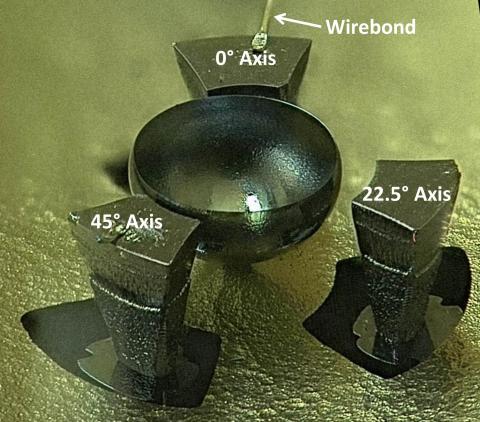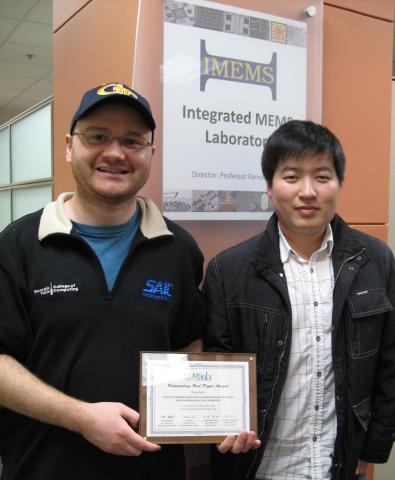Georgia Tech Ph.D. students Logan Sorenson and Peng Shao received the Outstanding Oral Paper Award at the 26th IEEE International Conference on Micro Electro Mechanical Systems, held January 20-24, 2013 in Taipei, Taiwan.
Logan Sorenson and Peng Shao received the Outstanding Oral Paper Award at the 26th IEEE International Conference on Micro Electro Mechanical Systems, held January 20-24, 2013 in Taipei, Taiwan.
Their award-winning paper, entitled "Effect of Thickness Anisotropy on Degenerate Modes in Oxide Micro-Hemispherical Shell Resonators," was co-written with their Ph.D. advisor and director of the Integrated MEMS (IMEMS) Laboratory, Farrokh Ayazi. Mr. Sorenson is a Ph.D. student in the School of Electrical and Computer Engineering (ECE) and Mr. Shao is a Ph.D. student in the George W. Woodruff School of Mechanical Engineering, while Dr. Ayazi is a professor in ECE.
Microelectromechanical systems (MEMS) devices are an enabling technology to power novel applications in next generation smart phones such as motion sensing, navigation, air quality monitoring, wireless communications, and timing. Limited by fabrication resolution, traditional 2D planar MEMS devices face great challenges for further size reduction as demanded by Moore's law. In contrast, 3D MEMS structures can overcome these fabrication limitations by taking advantage of the inherent symmetry of diffusion-based processes to create nearly perfect devices.
An example of 3D MEMS devices are the micro-hemispherical shell resonators (micro-HSRs) developed over the past two years by the IMEMS Lab through a DARPA-funded project in collaboration with Northrop Grumman. These resonators consist of millimeter diameter silicon dioxide micro-wineglass shells surrounded by electrodes for electrostatic actuation of the mechanical resonance modes of the shells. The thickness to diameter ratio of these ultra-miniature wineglasses is about 1:1000, or approximately the same as a beach ball, yet they show remarkable structural resilience.
A distinguishing feature of the Georgia Tech approach is to blend and adapt traditional micromachining techniques for the purpose of creating the 3D micro-wineglasses with monolithically-integrated electrodes to create these truly unique devices with unprecedented symmetry for the first time. A key technology developed by this work is the generation of freestanding silicon dioxide wineglasses by thermal oxidation of a silicon wafer in which hemispherical cavity molds were first formed by an isotropic etch process.
If there are any systematic variations in the oxide growth, such as those arising from the crystallinity of the silicon mold wafer, the symmetry of the shell would be broken, perturbing the two ideally-degenerate principle mechanical modes of the structure and leading to a split in the frequency response of the resonator. The scope of the presented work was to theoretically and numerically study the effect of the expected oxide growth variations as sources of anisotropy in the shells, and compare these estimates with observed frequency splits in the prototype micro-HSRs. A very small frequency split is needed to turn the micro-HSRs into high performance rotation sensors, or gyroscopes.
Spurred on by the early success of their project, this interdisciplinary team is continuing their theoretical investigations into other sources of structural anisotropy and using these results to develop new prototypes of even more perfect structures.
Additional Images

